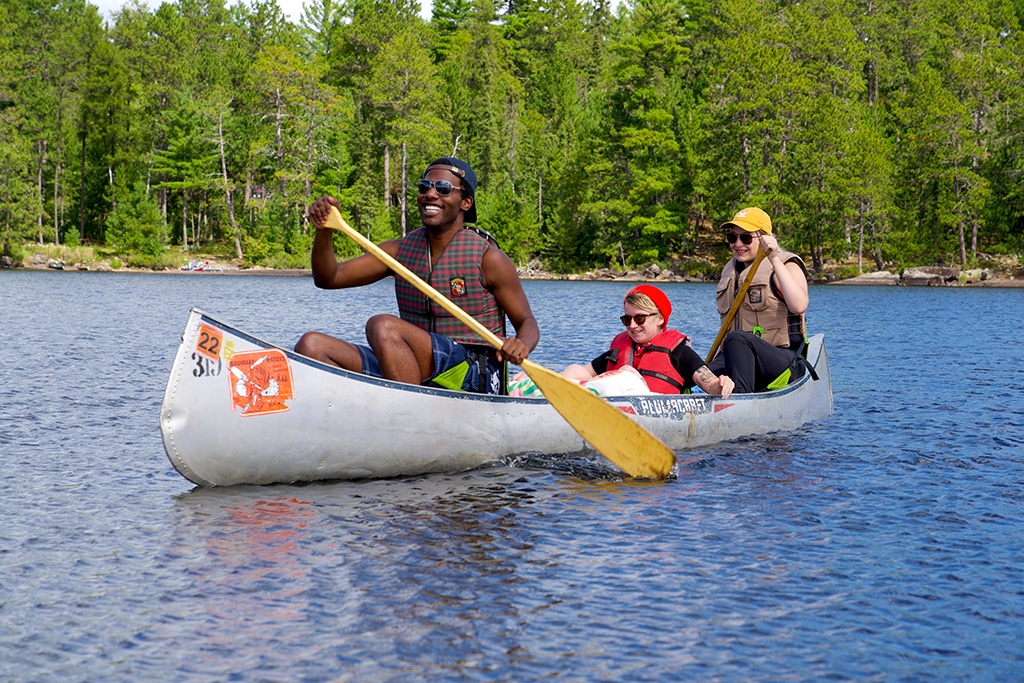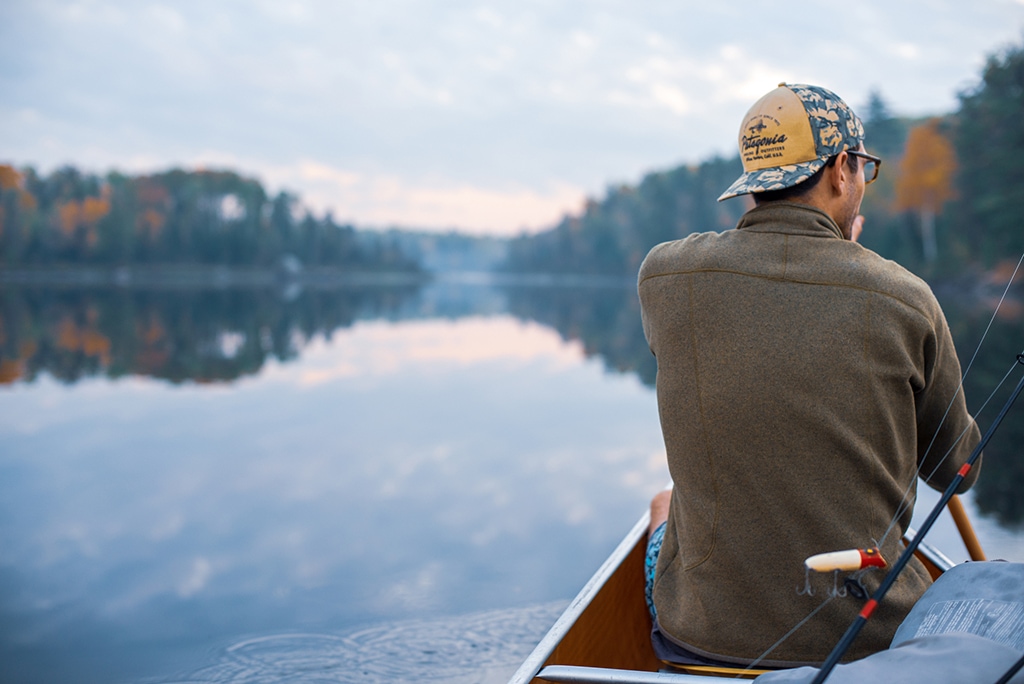Northern Minnesota—“sky-tinted water” in the Dakota language—is best navigated via canoe. Here, nearly 1,175 lakes are linked to one another via maintained portages and/or direct water connections, with 1,000 more secluded in this boreal world of pine and spruce. Some the size of a city block, others as large as New York City’s Central Park 12 times over, the lakes are oligotrophic, drinkable and their magnificent forested surroundings a carbon sink. Known as the Boundary Waters, an ecosystem that stretches well into Ontario province, this region is the most-visited federal wilderness area in the country and the greatest canoe-country wilderness in the world, where countless generations have gone fishing, canoe camping, hiking, bird-watching and waterfall-chasing. The waters have been classified as nearly “pristine.” But in 2019, a proposed copper mine threatened to change the lakeland wilderness’s landscape forever.
Donna Baumgartner has canoed the Boundary Waters every year—minus two—since 1963. “Kahshahpiwi Lake is my favorite,” says the 72-year-old, picking a spot that requires three days of hard paddling from Moose Lake and a mile-long portage across fields of boulders, wetlands and virgin pine forest. “It’s simply beautiful,” she explains. “You go anywhere in the Boundary Waters, and it’s just wilderness.” She recalls run-ins with bears, bathing beneath waterfalls, counting dozens of loons floating on the water’s gemmy surface. “It’s so pristine, so quiet—you can just drink the damn water.”
Technically, Baumgartner’s beloved Kahshahpiwi Lake falls into Canada’s Quetico Provincial Park, but water doesn’t much care about borders, international or otherwise. Flowing north from Minnesota’s 21-mile Birch Lake—a haven for anglers, campers and paddlers—the watershed courses through the Super National Forest and into the Boundary Waters Canoe Area Wilderness (BWCAW), Voyageurs National Park and Quetico, with 1,200-plus miles of canoe trails connecting it all.
Upon Baumgartner’s first visit, this boreal maze was simply a canoe area. “It wasn’t until the 1964 Wilderness Act that the Boundary Waters received a wilderness designation,” explains Samantha Chadwick, associate director of Northeastern Minnesotans for Wilderness and the Campaign to Save the Boundary Waters. The act, signed by President Lyndon B. Johnson, protected 1,090,000 acres of this immaculate water world, and protections in 1978 went further, limiting motorized use and restricting logging and mining in designated areas.

But the wilderness designation didn’t protect the entire watershed. Though Quetico, Voyageurs and the Boundary Waters comprise over 2.2 million acres, with unprotected headwaters farther south, the entire intact wilderness remains vulnerable—and the threat of copper mining has been looming over the area for decades. “Without further protection,” Chadwick adds, “you could place America’s most toxic industry outside America’s most popular wilderness.”
That’s what almost happened, and still could.
The Heavy Metal Threat
Since 1966, Twin Metals Minnesota has held two mineral leases along the South Kawishiwi River and Birch Lake, just 3 miles from the wilderness’s border. Though the initial 20-year leases have been renewed three times over the past 50 years, no mining has ever taken place. What’s more, no sulfide-ore copper mining has ever taken place here, or anywhere in the state of Minnesota.
In 2015, Antofagasta—a Chilean mining conglomerate—purchased Twin Metals Minnesota and proposed an underground sulfide-ore copper mine just upstream from the Boundary Waters, in the exceptionally clean Rainy River Watershed.
This type of mining is notoriously harmful, yet with the transition to green energy, demand is exploding; Goldman Sachs even declared copper “the new oil.” From lithium-ion batteries and wind turbines to solar panels and electric cars (all of which call for copper), the push for more metal to power the green economy could also be pushing us toward damaging the very landscapes we’re trying to protect.
Here’s how: Copper bonds to sulfide-bearing ore, which becomes waste rock in the metal’s extraction. Metals (copper, nickel, platinum and palladium) are found in 1% of the ore; the rest—nearly 20,000 tons per day, in Twin Metals’ case—would become what’s known as tailings. In the past, companies often stockpiled these tailings in ponds or impoundment dams, but that method has resulted in environmental disaster and loss of human life, many times over. The industry is moving toward a method known as “dry stacking,” where waste gets compacted in a mound with native soil and vegetation. Per the Department of Natural Resources, the state agency responsible for protecting local land, water, fish and wildlife, this method simply isn’t appropriate for lake-rich northern Minnesota: Toxic “fugitive dust” would escape into the air when dry; when wet, groundwater and surface water contamination would be inevitable, with acid mine drainage coursing through the wetland-filled landscape.
But this “safer” waste-disposal method doesn’t appear to cut it in any climate: In a recent study by the U.S. Forest Service, 100% of U.S. copper-sulfide mines experienced pipeline spills or accidental releases, and 92% experienced water collection and treatment failures that resulted in significantly harmed water quality. Recognizing what was at stake, the U.S. Forest Service denied Twin Metals’ leases in December 2016, citing “the inherent risk of irreparable harm.” (In that same document, the USFS also cites ventilation concerns, noise and the no-small-matter of deforestation, wreaking climate havoc on this invaluable boreal-forest ecosystem.) The Trump Administration restored the leases in 2019; the Biden Administration canceled them again in 2022 after finding they were “improperly renewed.” Twin Metals issued a federal suit this past summer in an attempt to reestablish mining rights. Now, this vast wilderness hangs in the lurch.
The Chance of a Lifetime
With 165,000 annual visitors, BWCAW is the most-visited wilderness in the nation, and many also deem it the most accessible, as it covers so much ground, with entry points suitable for both novice and experienced outdoor-adventure seekers. “The Boundary Waters is a part of so many of us,” says Baumgartner, recalling 60 years of memories—climbing up to Louisa Falls, buying lake-brewed root beer from “Knife Lake Dorothy,” learning to haul a 70-pound canoe at age 13. “It’s unlike anywhere else in the country,” she continues. “How can you possibly mine it?”
She’s not alone in her sentiments. According to poll results, 70% of Minnesotans oppose copper-nickel mining near the BWCAW. Last January, state legislators introduced a Prove It First bill that would require mines to deliver at least one example of a similar mine that both operated and closed without causing pollution or contamination of any kind. (This bill was recently reintroduced.) This past summer, the U.S. Forestry Service issued a draft environmental assessment as a proposal to recommend that Secretary of the Interior Deb Haaland grant a 20-year ban on mining in the Rainy River Watershed of Superior National Forest, upstream from the Boundary Waters. The report cites various detrimental outcomes should mining be permitted in the area, including adverse affects or complete removal of Indigenous cultural and natural resources, a high risk of water pollution and potential dam failure, soil degradation and more. Interior Secretary Haaland has yet to make a final decision about the ban.
But now, thanks to a federal bill reintroduced into the House of Representatives by Minnesota’s Betty McCollum, permanent protections are looking possible. H.R. 2794 would completely prohibit sulfide-ore copper mining on 234,328 acres of federal land and waters in the Rainy River Watershed, ensuring a future rich with Indigenous wild-rice harvesting, loons wailing on the waters, paddlers dipping their cups into crystal-clear waters and 13-year-olds learning to haul canoes.
“I’m pleased the bill has passed the House Natural Resources Committee,” said Rep. McCollum in a statement. “I’m working with our leadership to bring it to the full House for a vote before the end of this Congress. From hunter and angler groups to environmental advocates to the majority of Minnesotans, support is strong for protecting this important place. It is my hope that the progress we’ve made in the House will spur Senate action and support for enacting this permanent mineral withdrawal. Some places are simply too precious to mine.”
Indeed, supporters like Chadwick believe that the bill has gained enough momentum to potentially pass in both the House and Senate. “We believe it’s the best chance we’ve had to pass this bill in our 10 years,” she says, referring to the campaign’s tenure. “You don’t get chances like this—anywhere in the country—often for years or decades.”

But support gets stickier the closer you get to the wilderness. The 41,000-member, six-band Minnesota Chippewa Tribe—three of which retain hunting, fishing and gathering rights on this land via the Treaty of LaPointe, 1854—issued a letter supporting increased protections for the watershed. “It is unacceptable to trade this precious landscape and our way of life,” the letter reads, “to enrich foreign mining companies that will leave a legacy of degradation that will last forever.” It’s the first time the group has issued such a statement, and pushback was immediate: Conservative politicians and pro-mining groups called for a boycott of the Bois Forte–owned Fortune Bay Resort Casino; Chuck Novak, mayor of Ely, a popular BWCAW entry point, went so far as to encourage a boycott of all tribally owned businesses.
If you ask Becky Rom, national chair of Save the Boundary Waters, Ely’s elected officials aren’t representative of everyone who lives in and around this wilderness’s gateway town—most locals who live outside city limits, like Rom does, want to see their backyards protected. “Community leaders have sacrificed significantly over the last 10 years by going to Washington many, many, many times to advocate for the Quetico-Superior ecosystem,” emphasizes Rom. “But it is a divided community. Many people think of mining of the past.” Ely had rich hematite iron-ore mines that operated until 1967, the longtime activist notes, and that was the last time there was a mine in town. “I think, to some degree, they conflate taconite mining with copper-nickel mining, not appreciating how much more environmentally destructive copper-nickel mining truly is,” she says.
While the push-pull between industry and the environment seems permanently embedded in Ely’s fabric, the race to pass H.R. 2794 is running against the clock. “I’m optimistic that the Biden administration and in particular Interior Secretary Haaland will issue a public land order protecting Superior National Forest lands and minerals from copper-nickel mining,” says Rom. “But that’s a ban for 20 years. The Boundary Waters is not a 20-year wilderness—it’s a permanent wilderness, and we need a permanent ban on copper-nickel mining in the headwaters.”
H.R. 2794—which would equate to that permanent ban on much of the headwaters—awaits its vote on the floor of the House. If passed, it would then get wrapped into a public-lands package that Congress could still pass in 2022. Of 52 cosponsors, none is Republican, and without bipartisan support, it hangs in the balance after the midterm elections. “We’ve come a long way, but we have to finish the job in 2022,” says Rom.
The whirlwind shows no sign of stopping—between corporate lawsuits, local tension and a potential switch in majority parties, the Boundary Waters remain on a precipice. But though only so many days remain, 2022 could still prove to be a banner year for America’s most-visited wilderness.
“[This ecosystem] has an important role in terms of climate resilience and adaptation, and it’s important for its own sake—it’s the greatest canoe-country wilderness in the world,” says Rom. “But it is utterly dependent on all of us to fight for it.”



